Last updated: 7 November 2024
When it was time to choose which university to go to, I didn’t really have much of a choice. My family’s finances drastically narrowed down my options to only two: a state university in the province or a state university in Metro Manila. I opted to pack my bags, leave my hometown, and build a life in the capital. It was a choice I’ve always been thankful for. Much of what I know now, I learned in UP, both inside and outside the classroom.
But one thing I truly enjoyed about the University of the Philippines was the environment. The UP Diliman campus is a completely different world. Every time the jeepney would make it past the welcome sign, I felt like we were driving into another dimension, away from the deafening noise and busy jolt of the city.
In this post, we’re looking at UP Diliman not as an academic institution but as a destination. My friend and UP batchmate Astrid and I return to the campus every year. Even over a decade after graduation, we still find every visit enjoyable. If you’ve never been to UP before, here are some things that you can do!
UP Lantern Parade and UP Fair
If your timing is right, you can witness two of the biggest festivals within the campus. Both the UP Lantern Parade and the UP Fair have long been embedded in the university culture but also attract swarms of visitors.
The UP Lantern Parade happens in December, a week or two before Christmas. The university’s various colleges and organizations design and build a giant lantern and parade them along the Academic Oval. During the presentation, which happens behind Quezon Hall, students also perform a quick number to showcase their lanterns.
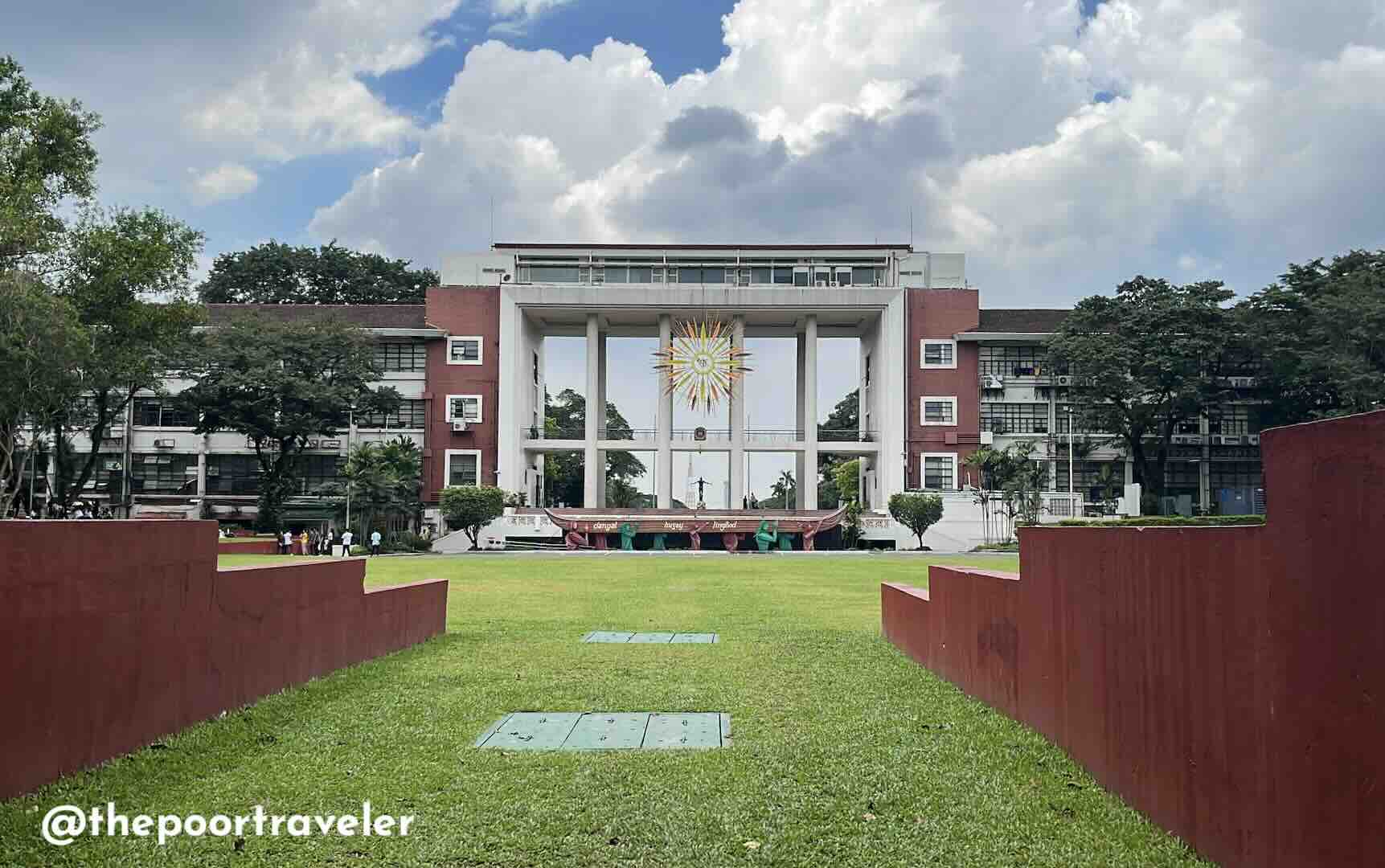
On the other hand, the UP Fair is an annual 5-day musical fest featuring local bands and performers. It is staged at the Sunken Garden in February, but according to a Rappler report, in the 1970s, it took place in September as a sign of protest against Martial Law. Aside from the music, there are also food stalls and a few rides and attractions that you can enjoy!
Street Food Trip
Street food is an integral part of UP life. Reviews are powered by fishballs and siomai. Org meetings are fueled by kwek-kwek. Friendships are bound by isaw. I have a number of friends who normally refuse to eat street food but have no problem if it’s in UP, primarily because of the regular sanitation checks, something that is absent in most places outside.

Mang Larry’s Isaw is probably the most popular street food place in the campus. It has changed location through the years, but patrons followed it everywhere. It started as a simple food cart, recognizable by the long queue that snakes from it and the numerous cars parked around it.
Presently, it has three branches: UP Branch (near College of Fine Arts), Magiting Branch, and UST Branch. Isaw manok and isaw baboy are the most popular, but atay (liver), balunan (gizzard), and a few others are also available.
Dining Spots
If street food isn’t your thing, you can find proper sit-down restaurants within the campus, too. Here are some of the popular dining spots in UP:
Rodic’s Diner
Started serving in 1949, Rodic’s is best known for its signature tapsilog, a Filipino dish composed of tapa flakes, sinangag (fried rice), and fried egg. It also offers other Pinoy comfort dishes including sinigang, dinuguan, caldereta, menudo, and lechon paksiw. Its first branch in UP was located inside the Shopping Center until March 2018 when the shopping center was severely damaged by fire. Currently, it found its new home at Epsilon Chi Center beside Bahay ng Alumni. It’s open daily from 6:00 AM to 9:00 PM.
Aside from the UP campus branch, it now has several branches in Metro Manila — Masaya and Maginhawa (UP Village), Visayas Avenue, Congressional Avenue, Dahlia Avenue, UP Manila, UP PGH, Pasig, Makati, Marikina, White Plains, and Parañaque.
Gubat
Tucked in a lush garden, this unconventional restaurant is famous for its great ambiance and delectable Pinoy food offerings. Although it has limited items on the menu, what makes it unique is the food presentation — big servings of meals on banana leaves. Yep, no plates here. Heads up: there are no utensils. You have to eat the “traditional” way — with your bare hands. If you’re up for the challenge, enjoy your chosen meal served with adobo rice, salted egg, and pakô salad.
The branch inside UP is located along C.P. Garcia Avenue. It has another branch along Mayaman Street in UP Village. Opening Hours: Tuesday to Sunday, 11:00 AM – 9:00 PM (C.P. Garcia Branch); Tuesday to Sunday, 10:00 AM – 9:00 PM (Mayaman St. Branch)
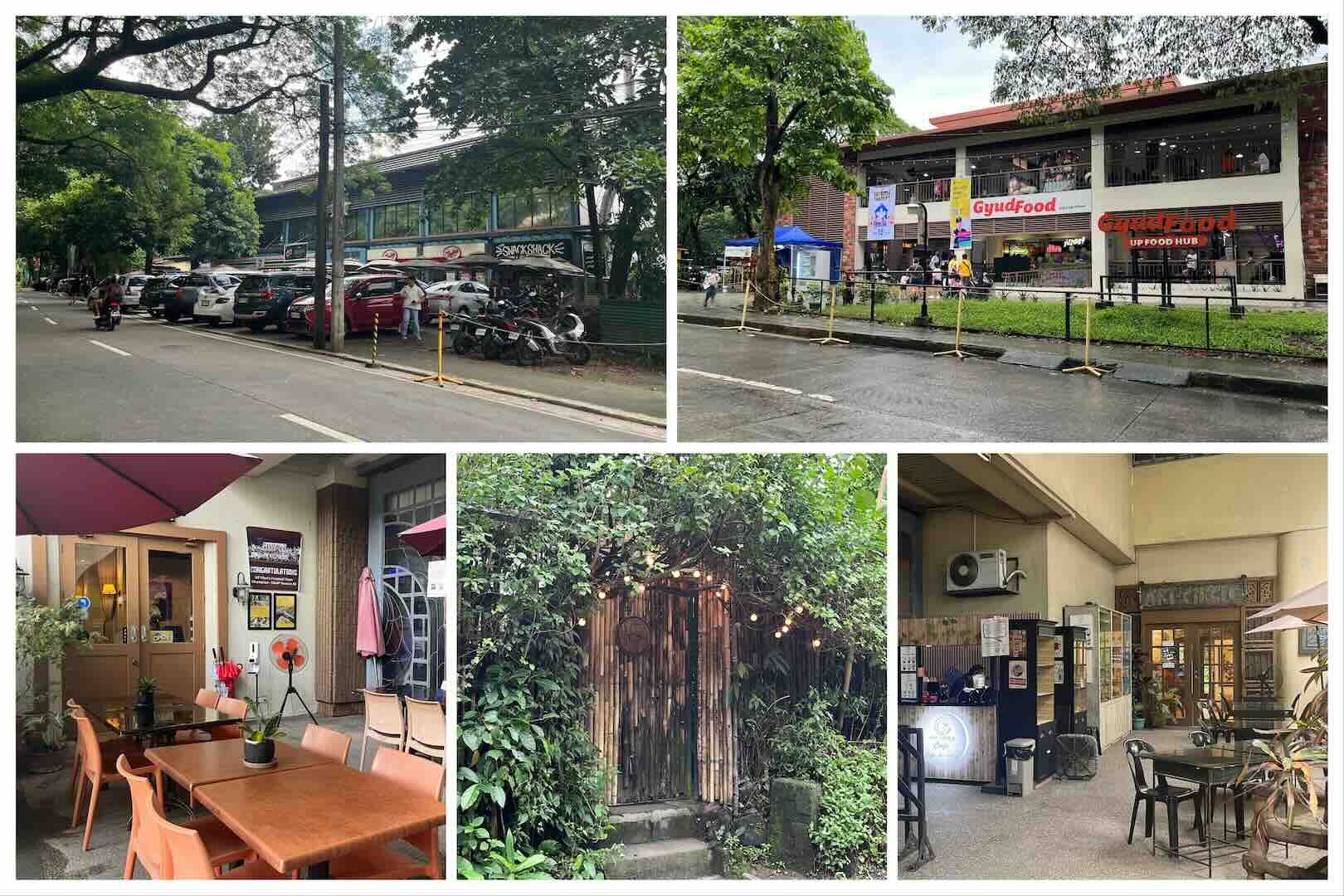
Other Food Places to Consider
- Art Circle Café. Housed in Bahay ng Alumni, it functions as a restaurant, a café, and an art gallery in one! Its menu includes pasta, desserts, coffee, and other comfort food. Opening Hours: Monday to Friday, 9:00 AM – 6:00 PM; Saturday to Sunday, 8:00 AM – 7:00 PM
- ROC (Restaurant-of-Choice). Also located at Bahay ng Alumni, it’s a quaint casual dining restaurant and café offering Filipino, Italian, and American selections. Opening Hours: Monday to Saturday, 9:00 AM – 6:00 PM
- Gyud Food. Launched to the public in December 2022, this food hub aims to promote local food vendors and entrepreneurs. Located across the College of Fine Arts, it serves both as a food park and a food court with various stalls inside the two-story multipurpose hall and on the al fresco ground. It also hosts activities and events. Opening Hours: Daily, 7:00 AM – 10:00 PM
- Other Food Joints at Epsilon Chi Center: The Snack Shack and Nomu Cafe. Both are located in Epsilon Chi Center, along with Rodic’s Diner.
Photo Walk
I mean, come on. For starters, the University Avenue, which is the road leading to the entrance where the Oblation statue welcomes you with arms wide open, is a sight to behold during graduation season because of the blooming sunflowers flanking it. Fronting Quezon Hall, the Oblation statue itself is a celebrity, always ready for photo ops.
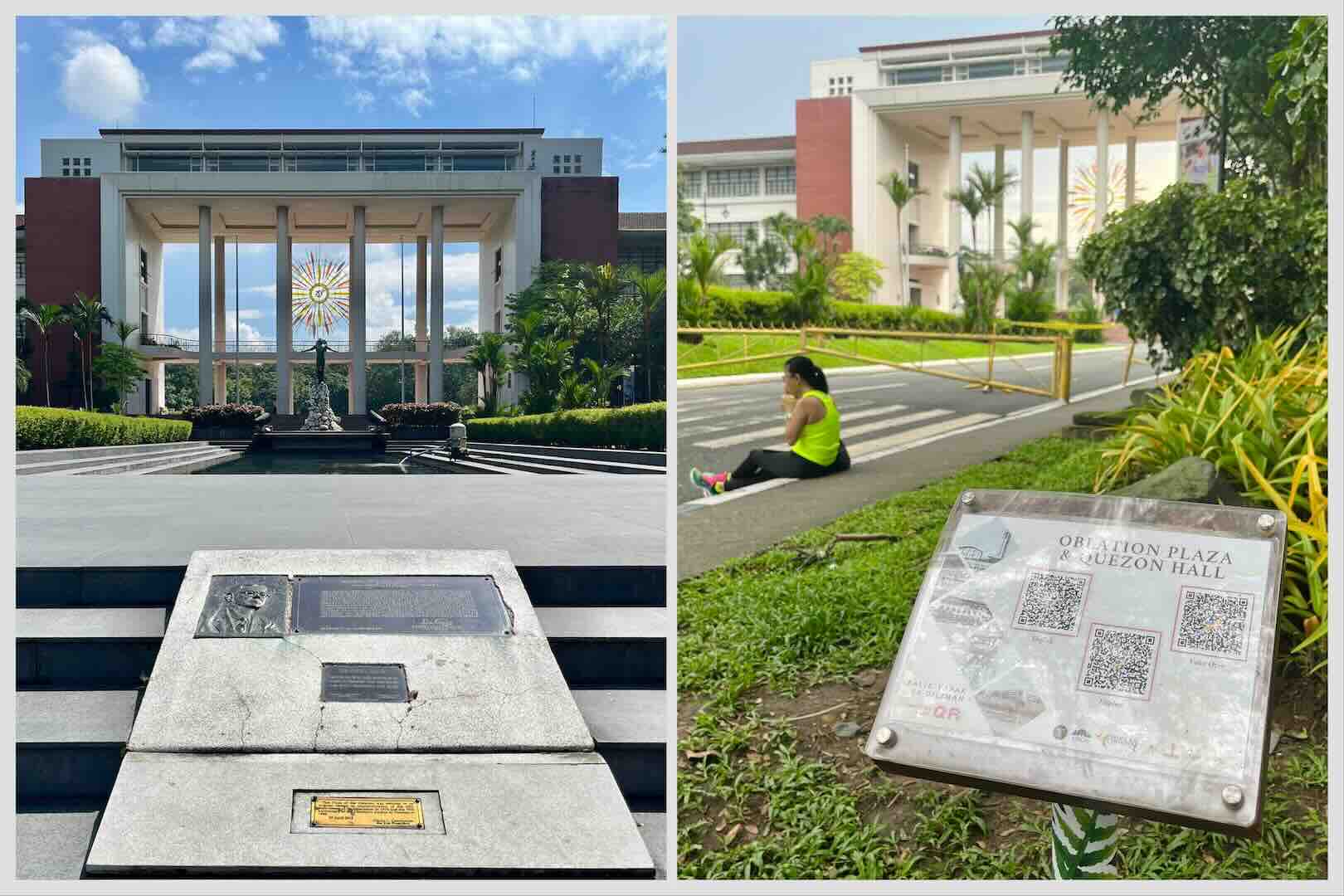
The University Academic Oval offers a delightful visual buffet, boasting the old buildings’ architecture and a refreshing green canopy. Did you know that Melchor Hall (College of Engineering) is Palma Hall’s (AS) mirror image? Same goes for Benitez Hall (College of Education) and Malcolm Hall (College of Law).
By the way, these four buildings plus Quezon Hall (Administration Building) and Gonzalez Hall (UP Main Library) are included in Balik-Yapak Walking Tour itinerary. A project of UP’s Asian Institute of Tourism, it provides information and audio guides with the help of QR codes.
In addition, the university houses over 30 historical structures, monuments and works of arts.
Acad Oval Jog

Since the university is “photogenic”, it is but natural that it’s also an encouraging place to get fit and get back into shape. The whole campus ground is jogger-friendly and biker-friendly. And speaking of Academic Oval, this iconic elliptical road can be considered the aorta of the UP Diliman campus. It works like the largest artery of the heart, pumping out blood throughout the body via the smaller arteries connected to it. Sounds like a good jump-off point for your fitness journey, right?
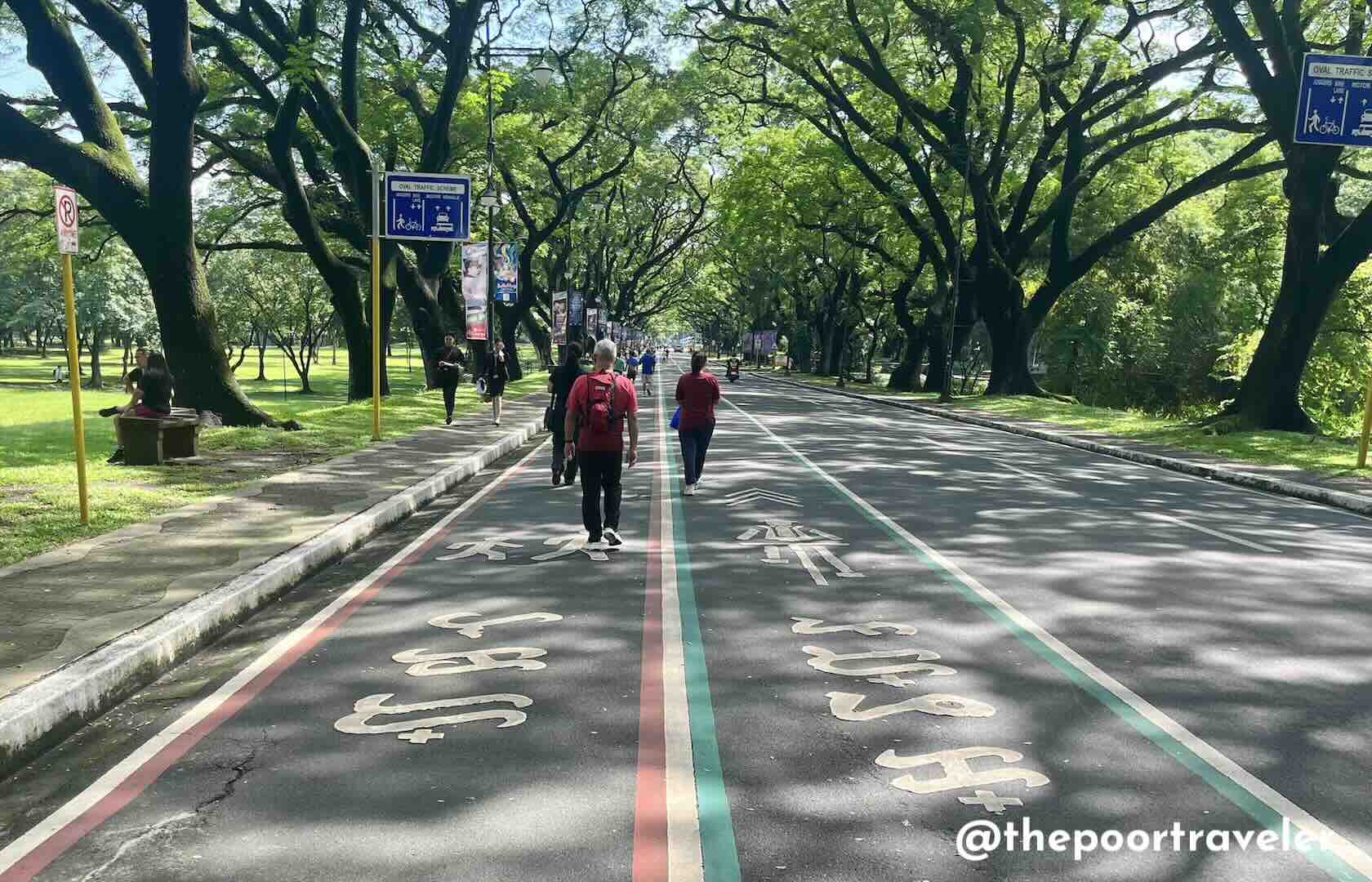
Well, good news! The half side of the Academic Oval’s road, for example, is closed to vehicles and is now solely for pedestrians and bikers’ use. The smell of grass and the sight of the lush canopy are so refreshing. I used to spot some celebrities jogging peacefully here.
Visit Vargas Museum
For art enthusiasts, Vargas Museum is worth a visit. The museum showcases the collections of Mr. Jorge B. Vargas, which he entrusted to the university. These collections include stamps, coins, memorabilia, arts, and books. The notable works of arts that you will see are those of Juan Luna, Fernando Amorsolo, Felix Hidalgo, and Victorio Edades. Entrance is free for the UP Community on Wednesdays.
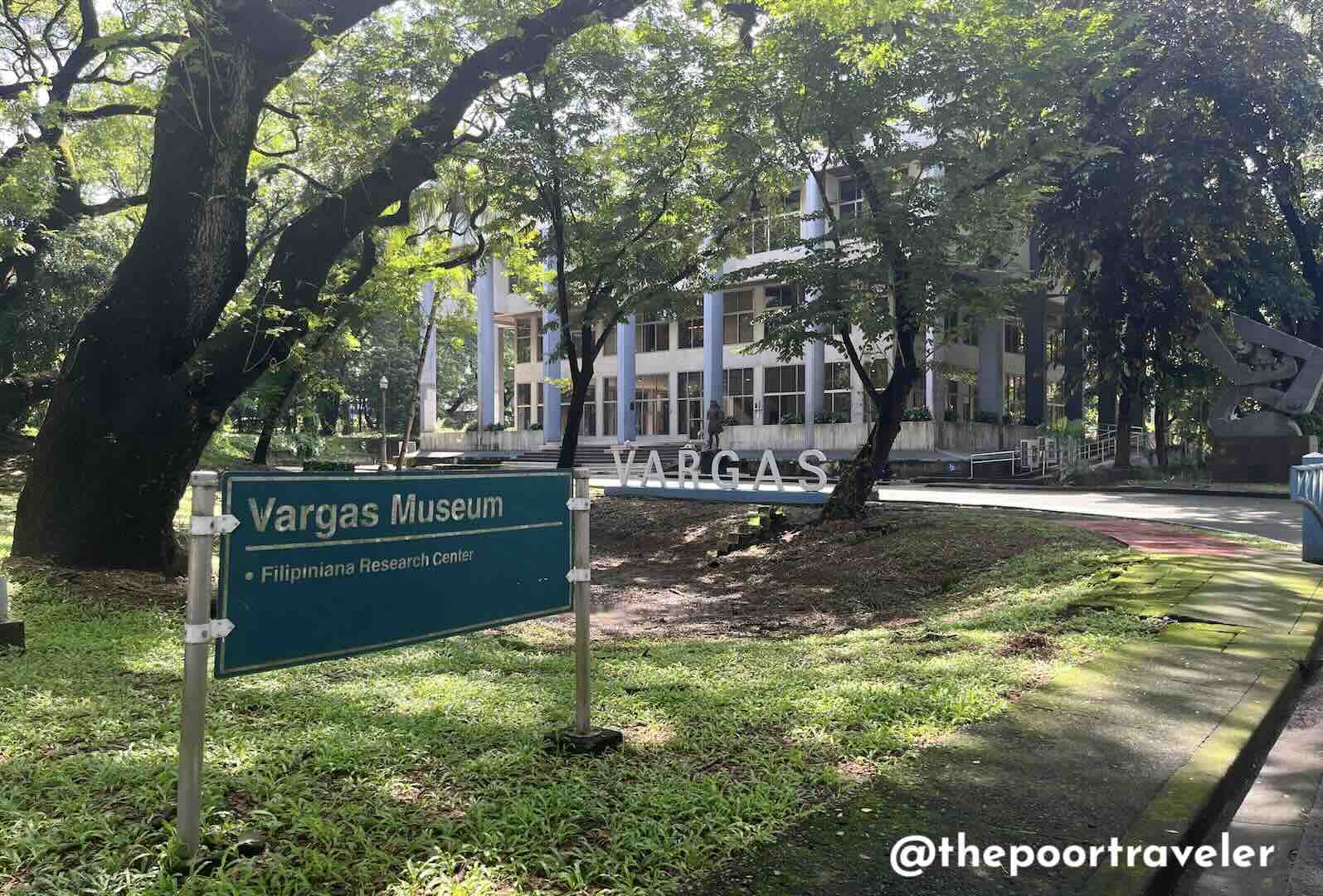
Opening Hours: Tuesday to Saturday, 9:00 AM – 5:00 PM; Monday & Sunday, CLOSED
Admission Rates: All Students, PWD & Senior Citizens, P20; UP Community, P40 (FREE every Wednesday);
Non-UP, P50
Guided Tours: P200 for groups of 10 people or LESS
Cine Adarna Film Screenings
Yep. You read it right. The University of the Philippines has its own cinema house, the UP Cine Adarna, located beside the UP Theater and the U.P. Carillon Tower. Aside from the cheaper admission ticket, you can also get a chance to catch screenings of hard-to-find and non-mainstream features, even student short films. It can showcase and screens films free from censorship for academic purposes.
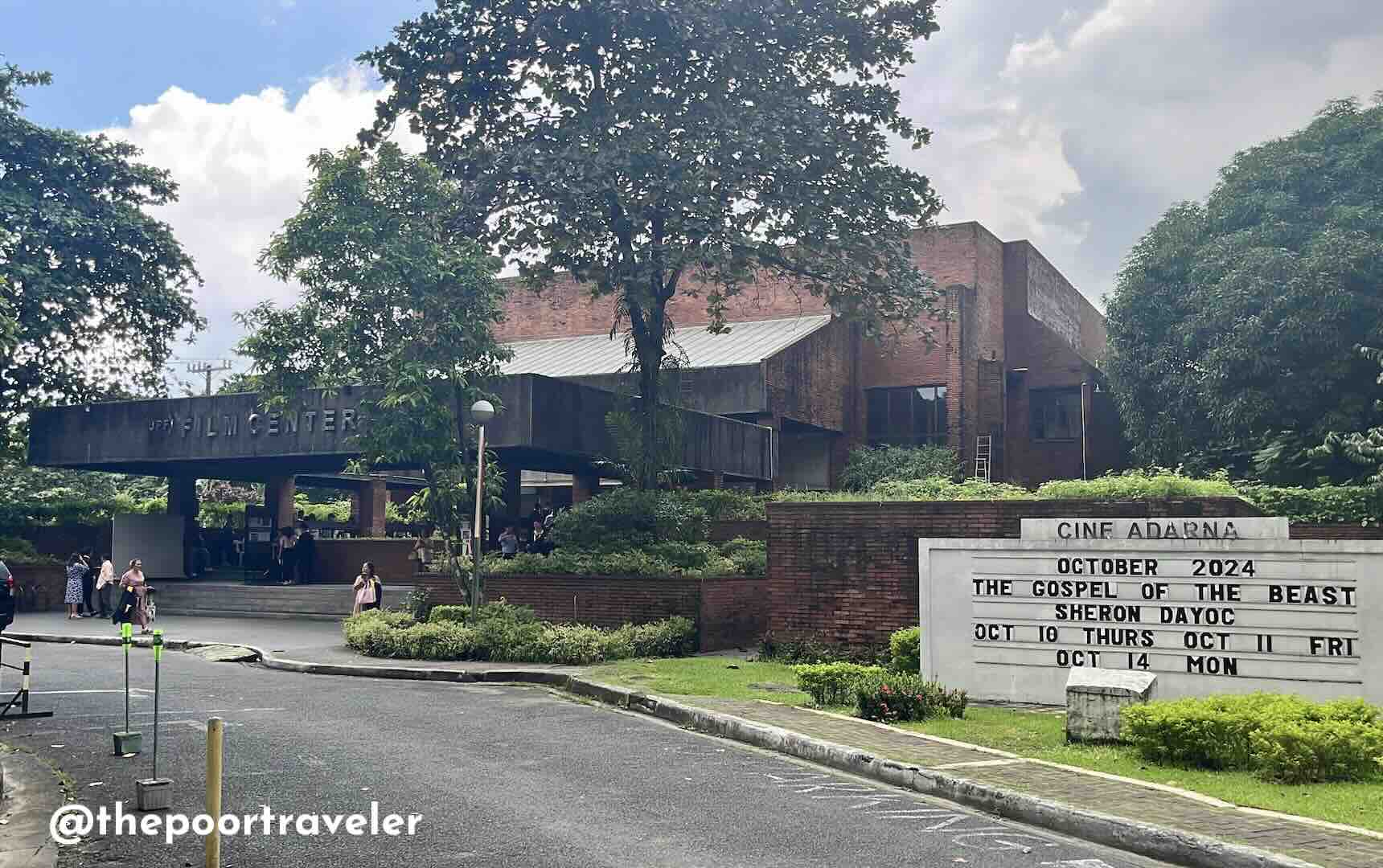
The UP Cine Adarna is also a choice venue for commencement exercises, recitals, and film festivals usually hosted by film organizations like the UP Cineastes Studio and UP Cinema.
Sculpture and Art Installations Hunting
UP Diliman is not only an esteemed academia but also a haven for art lovers. Name it, UPD has it! It boasts both tangible and intangible arts — from architecture to literature to music to cinema to theater to painting to sculpture. Two of the tangible art forms you can freely admire within the campus are public art installations and sculpture. They generously adorn the campus grounds, giving more “oomph” and meaning to each site.
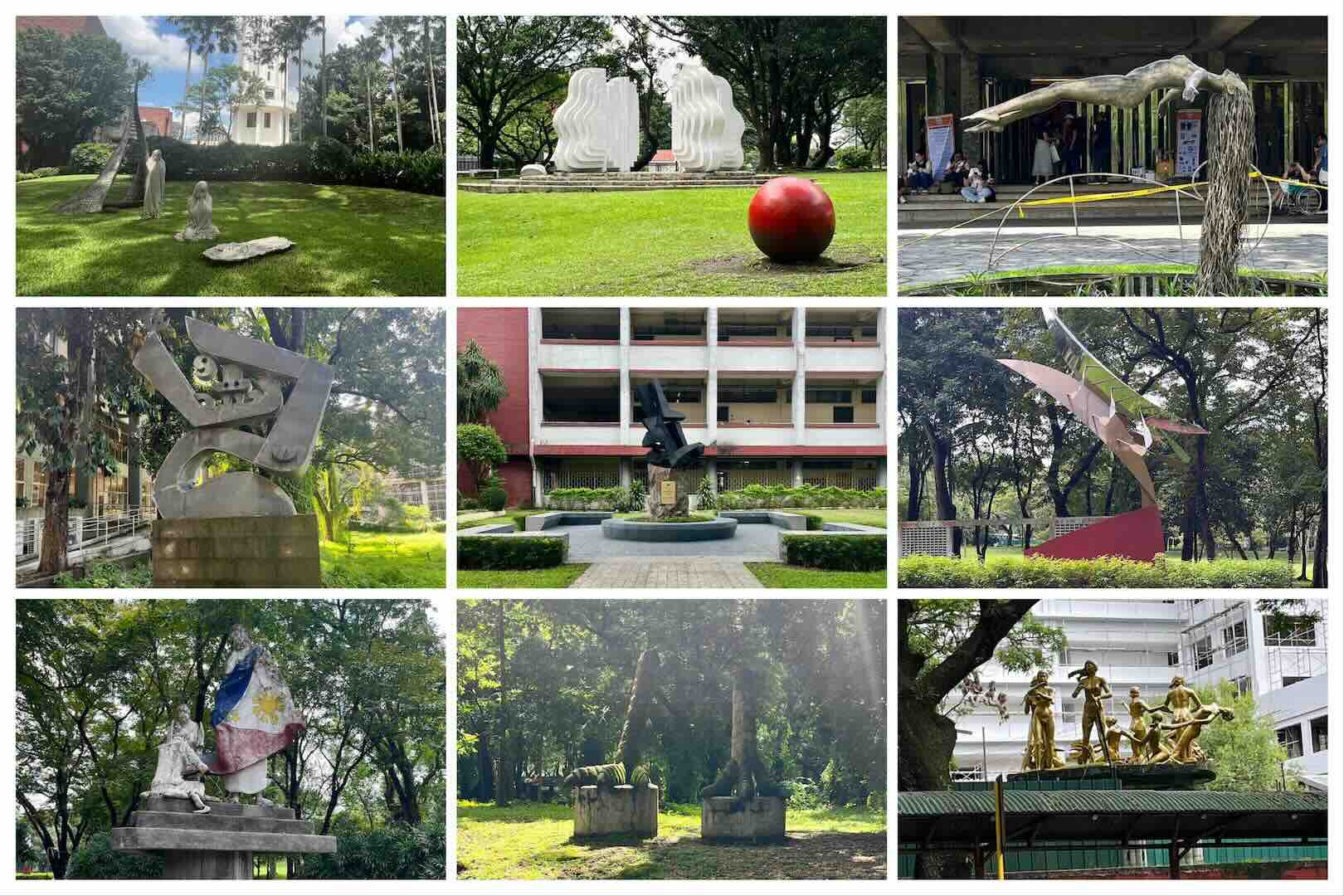
If you are on the hunt for these public art installations and sculptures, keep your eyes peeled for these visual treats!
Sunken Garden Musing
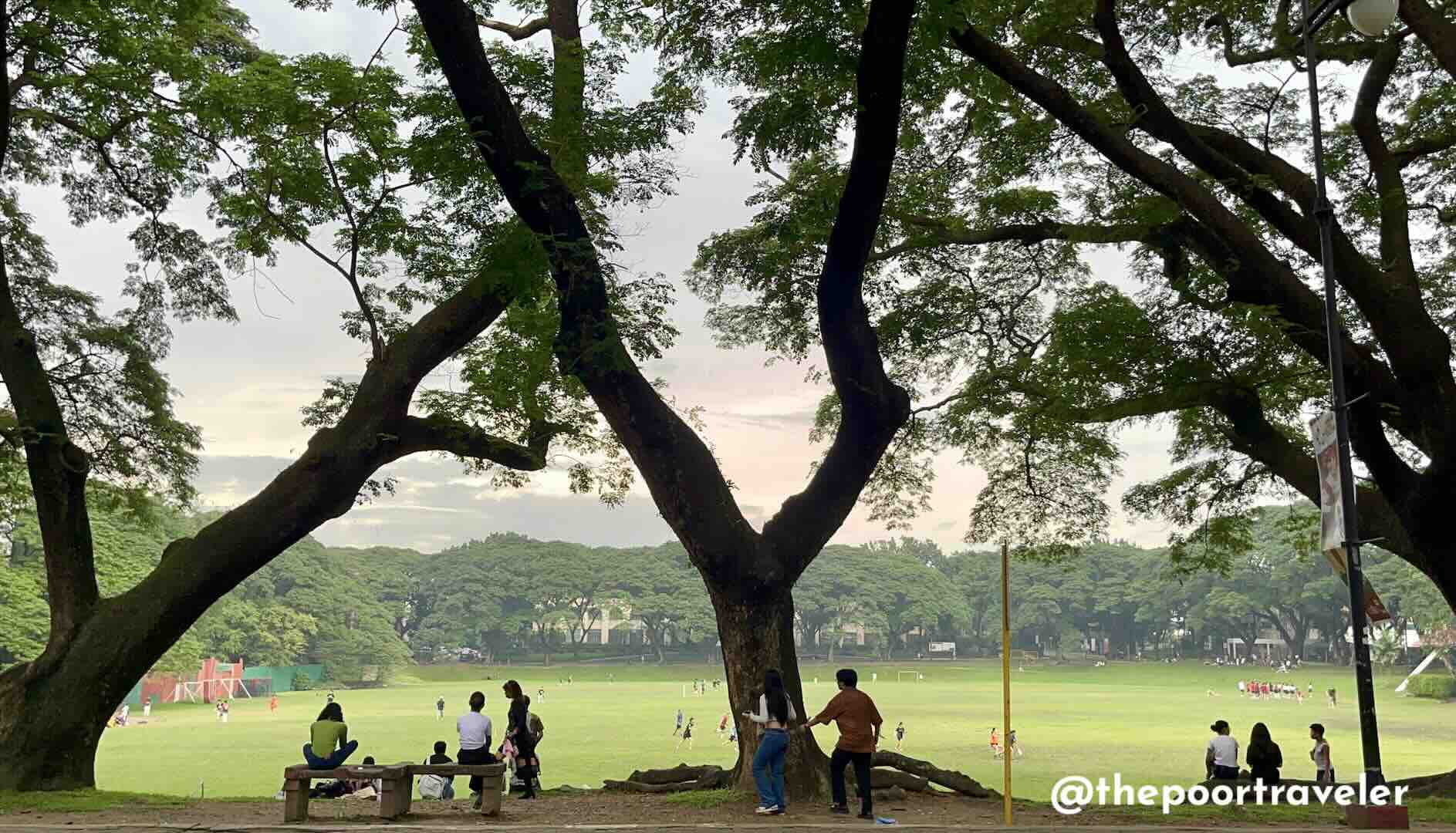
After “Oble” (Oblation Statue), the Sunken Garden is arguably the second most prominent feature in UP Diliman campus. It’s open to all, like a very approachable friend who is willing to listen to all your musings, rants, and problems.
Also, as previously mentioned, it has been home to many week-long UP Fair celebration spoiling us with well-loved OPM music.
Area 2 and Maginhawa Food Crawl
If you are a foodie who’s always searching for new places to eat, scour the streets of Laurel in Area 2 and Maginhawa in UP Village for hidden gastronomic gems!
During our college days, back in the early 2000s, Area 2, particularly J.P Laurel Street, used to be lined with residential houses — some are converted into boarding houses. The only food establishments here are Lutong Bahay and its rival, Lutong Kapitbahay. Fast forward to the 2020s, this unassuming street has developed into a bustling food strip! The food offerings here are on the cheaper side compared to those you’ll find at Gyud Food, so it’s really not surprising why a lot of students flock to this area. Your landmark is the PHL Post Office.
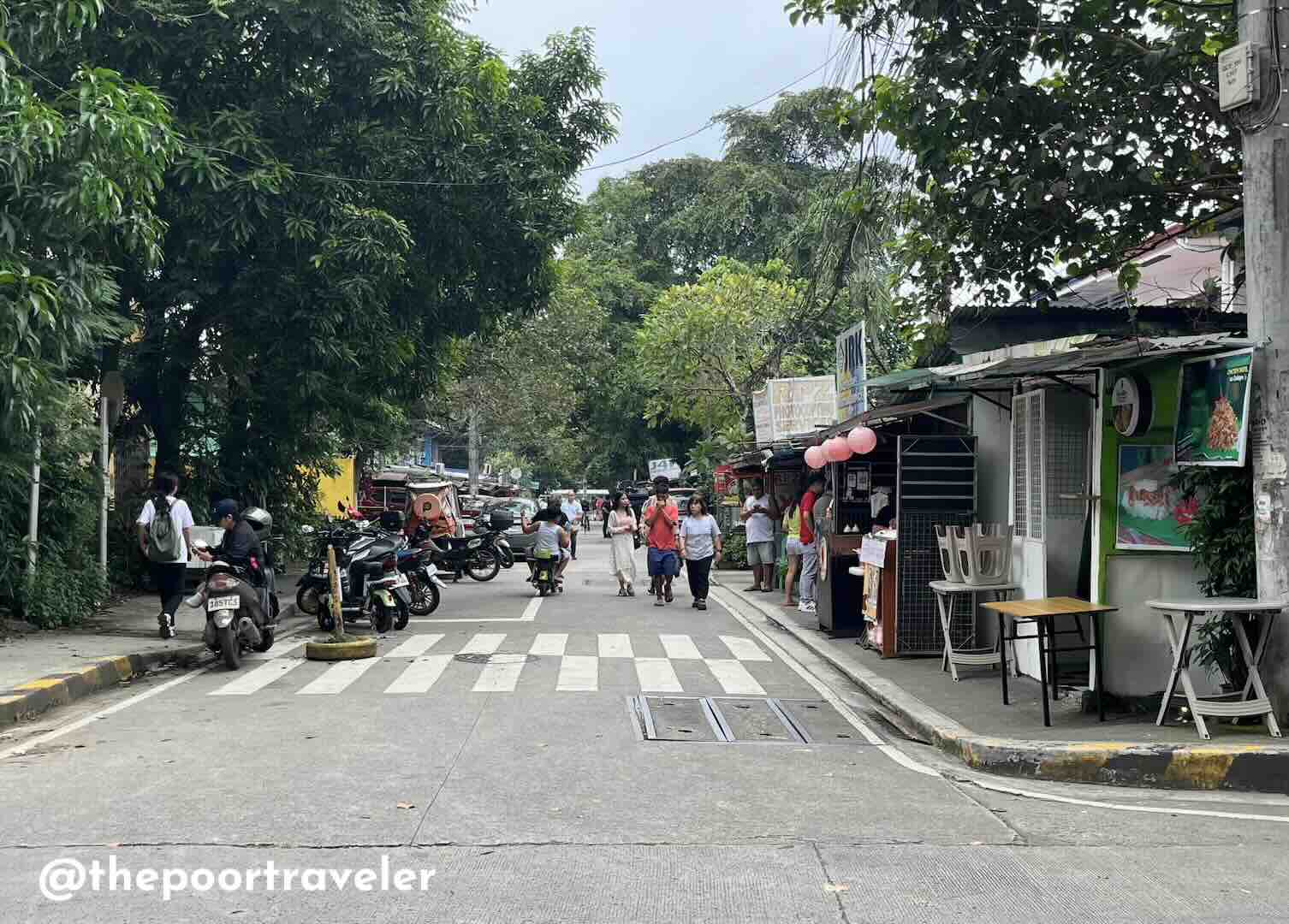
Maginhawa Street, the main artery of UP Village and Teacher’s Village, has gone a massive transformation since our student days. Back then, it was relatively quiet, with only a handful of eateries and bars like Tomato Kick, Grill Queen, and Ababu. Today, Maginhawa has evolved into a bona fide foodie paradise, flanked with countless food stalls and restaurants.
Some of the must-try restaurants are CAUTION HOT! Spicy Noodle House, PINO Restaurant, Friuli Trattoria, Provenciano, and Talisay The Garden Cafe.
Updates Log
2024 11 6 – Updated information and photos; added items (Area 2, Dining Spots, Public Art Installations, and Sunken Garden)
2018 12 2 – First uploaded
Written by: Yosh Dimen and Asta Alvarez
Photos by: Asta Alvarez and Yosh Dimen

























